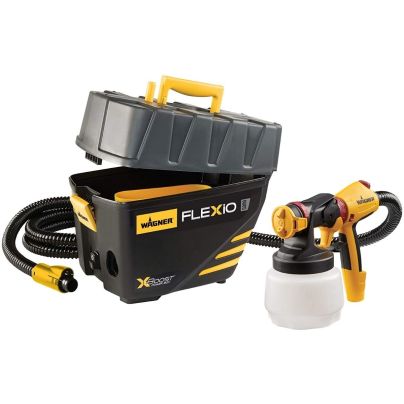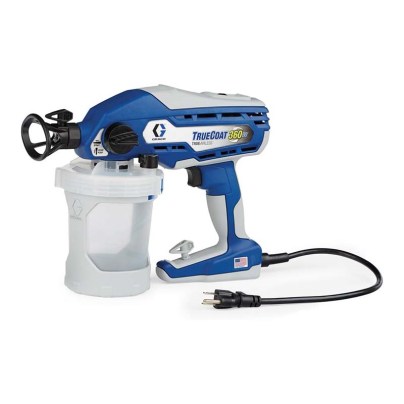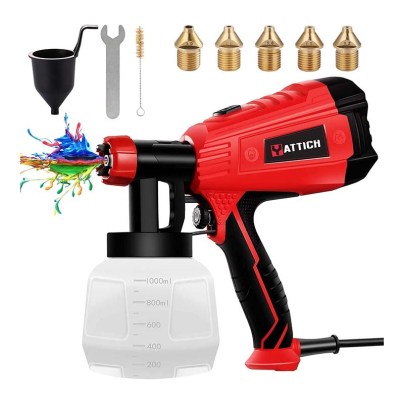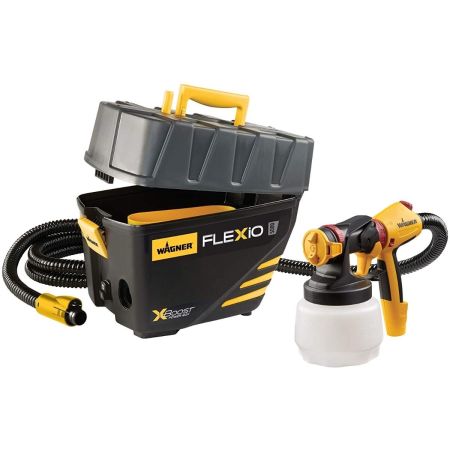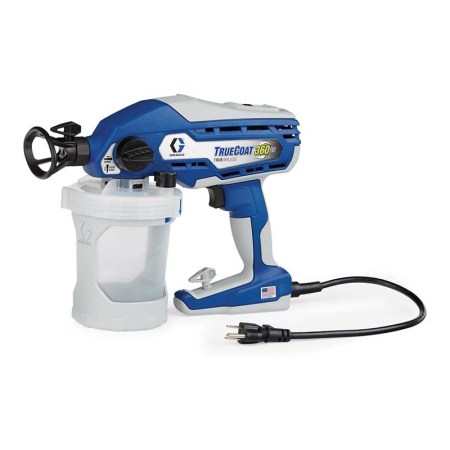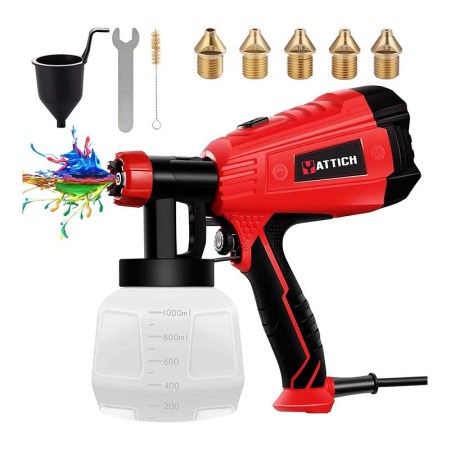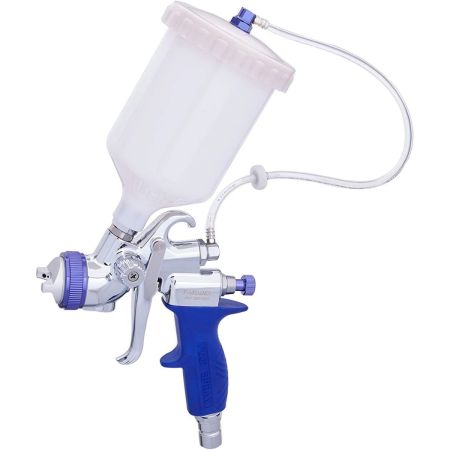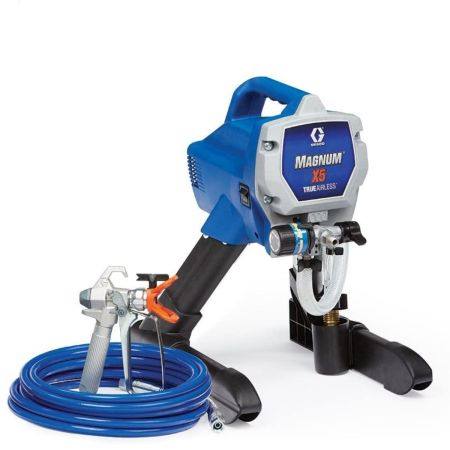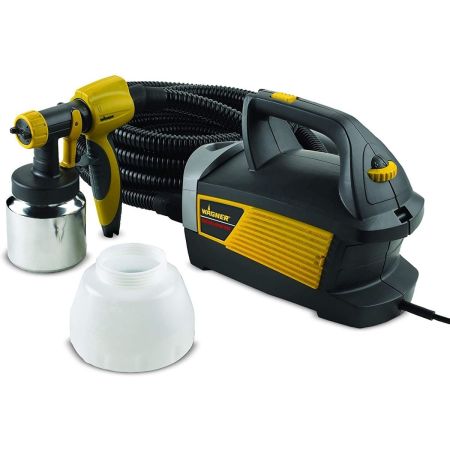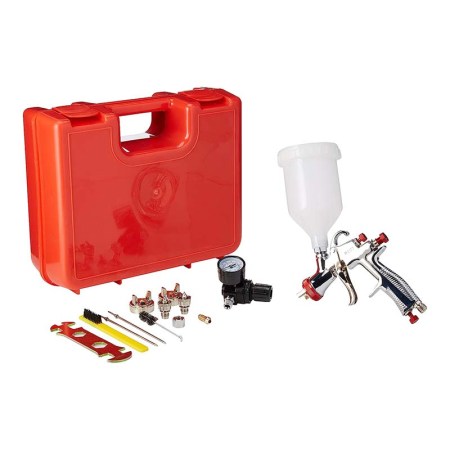We may earn revenue from the products available on this page and participate in affiliate programs. Learn More ›
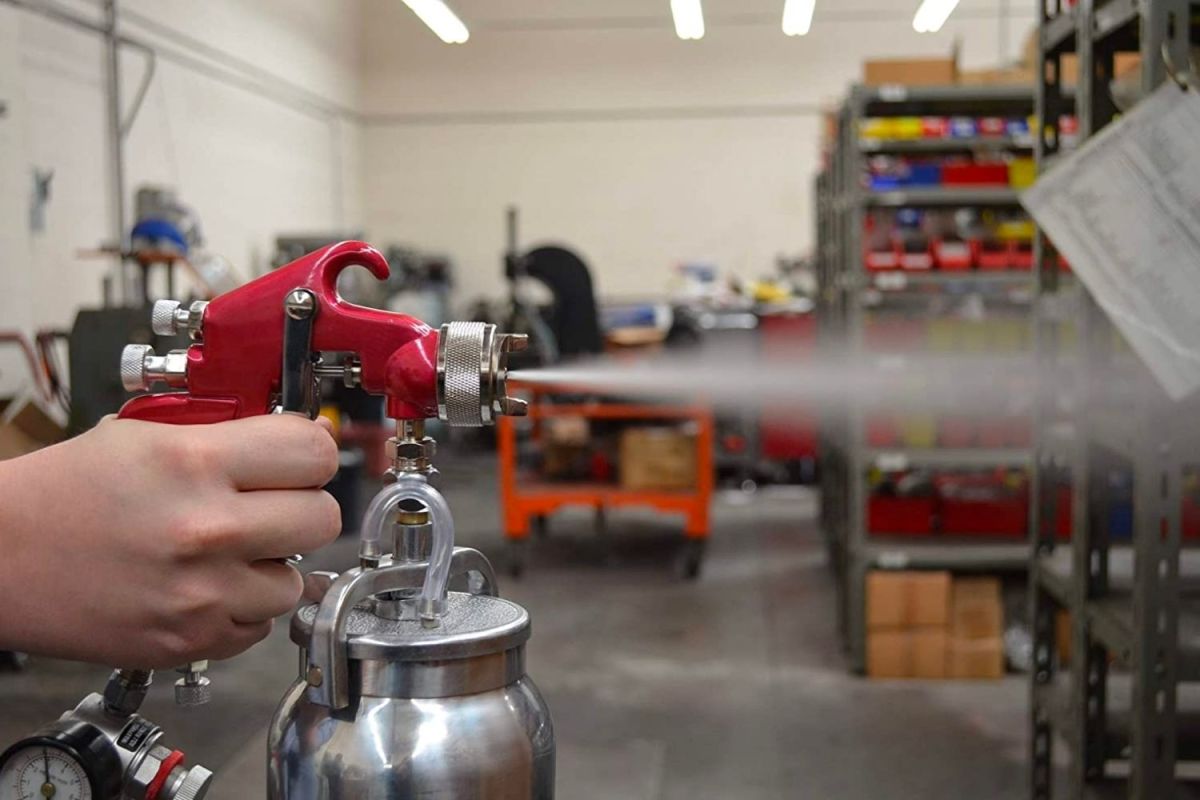
A fresh coat of paint can make kitchen cabinets look like new. Using a quality paint sprayer can help you achieve professional-looking results while saving you hundreds of dollars in labor costs.
A paint sprayer has a canister that holds the coating (paint, stain, etc.) while a trigger-operated nozzle sprays the product onto the surface. Since they distribute paint quickly and produce a smooth finish, they’re a much better option for painting kitchen cabinets than standard brushes or rollers.
This guide will discuss types of paint sprayers, shopping considerations, and top recommendations to help you find the best paint sprayer for cabinet refinishing. The list of top picks was assembled from an in-depth review of the market and thorough product vetting. We also tested a few of the sprayers on this list when compiling an overall list of the best paint sprayers.
- BEST OVERALL: Wagner Spraytech Flexio 5000 Sprayer
- RUNNER-UP: Graco TrueCoat 360 DS Paint Sprayer
- BEST BANG FOR THE BUCK: Yattich HVLP Paint Sprayer
- BEST SPRAY GUN: Fuji Spray Systems T75G Spray Gun
- BEST AIRLESS: Graco Magnum X5 Electric TrueAirless Sprayer
- BEST HVLP: Wagner Control Spray Max Sprayer
- BEST LVLP: SprayIt LVLP Gravity Feed Spray Gun Kit
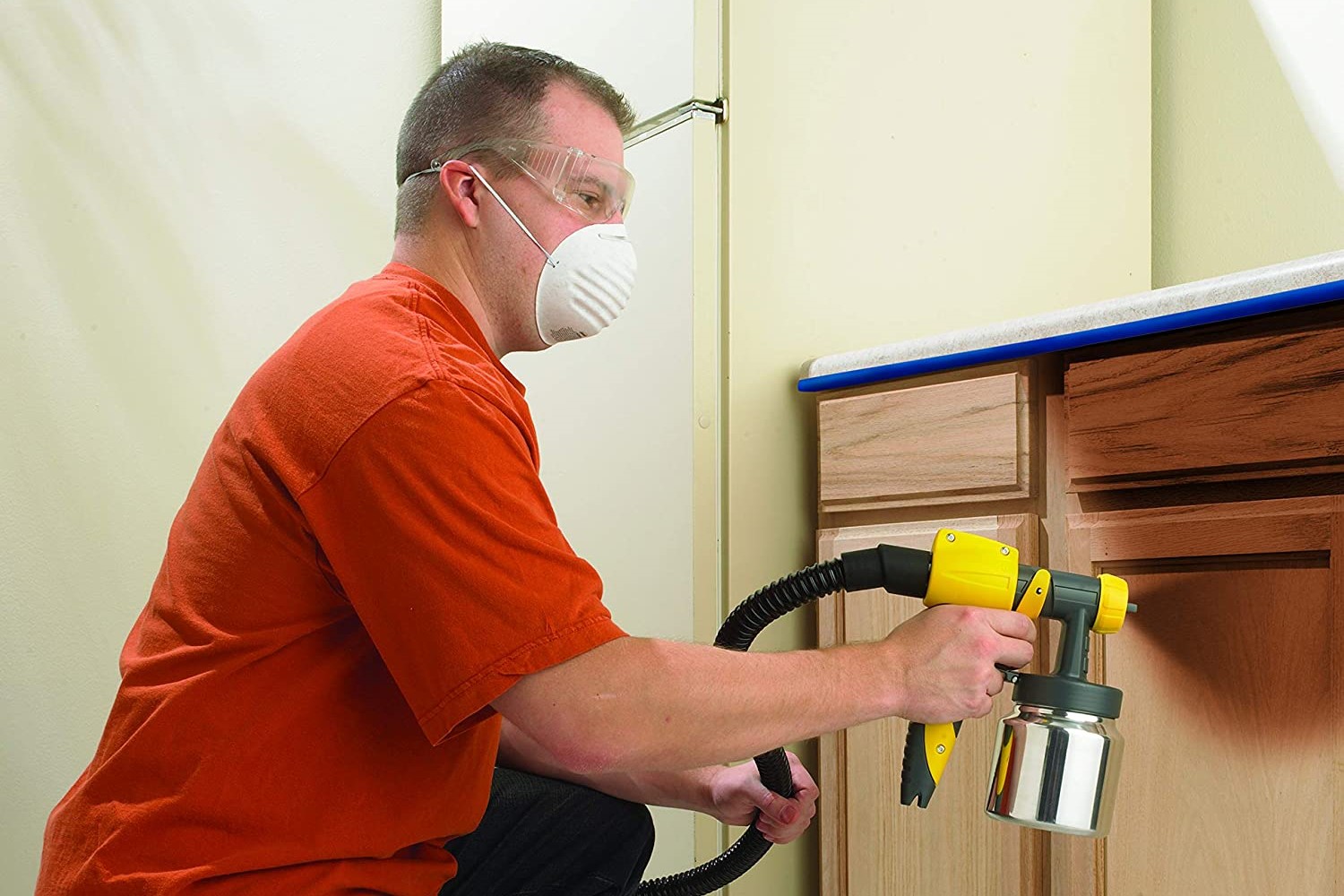
How We Chose the Best Paint Sprayers for Cabinets
Different types, capacities, weight, design features, and materials included on today’s paint sprayers can make it hard to pick one that can help with your specific cabinet painting project. But, HVLP, airless, conventional/compressed air, and LVLP sprayers are the most sought-after sprayers on the market since they are efficient, precise, and effective for either small or large projects.
These types of sprayers come with various capacities based on their intended use. High volume, low pressure (HVLP) sprayers are the most common in the above list, and they usually come with ample capacity to cover entire rooms or other large spaces. Airless spraying also allows for ample quantities of paint distribution, since they usually rely on pumping paint from a bucket to operate.
On the other hand, conventional/compressed air and low volume low pressure (LVLP) sprayers are effective on trim, window frames, and DIY projects for their smaller paint capacities and nozzle types. For convenience, all of the sprayers listed above are lightweight to reduce fatigue while spraying and many come with adjustable tips and nozzles, pressures, and pump types for your needs. Finally, most of these sprayers are constructed of plastic and stainless steel for durability and long lifespans.
Our Top Picks
The following products are quality sprayers for painting kitchen cabinets. They’re reasonably priced, easy to use, and offer plenty of adjustment options. To further assist readers in their search for the best paint sprayer, our team tested some of the products from the list of top picks. The results of those tests are included below.
Best Overall
Wagner Spraytech Flexio 5000 Sprayer
See ItWhen it comes to painting cabinets, a sprayer should provide good coverage with control, accuracy, and a minimal amount of overspray. That’s what you get with this HVLP sprayer from Wagner. The Spraytech Flexio includes a host of adjusters that allow you to change pattern width and direction, flow control, and power on the fly with a 1½-quart paint capacity.
Some paint sprayers house both the paint and the compressor, making them a little unwieldy and tiring to use for long periods. Wagner houses the motor in a turbine located in a separate base that connects to the sprayer via a hose, so it is more lightweight in use. The stationary base also doubles as a convenient storage bin for the sprayer and attachments.
Product Specs
- Type: HVLP
- Capacity: 1½ quarts
- Power rating: 120 volts
Pros
- Lightweight and portable design is easy to tote around during painting
- Users can adjust the material flow and pressure to their specific task
- The sprayer also comes with a detail finish nozzle
- Its base doubles as a storage bin for keeping accessories organized
Cons
- Smaller capacity might not be suitable for painting large areas
Get the Wagner Spraytech paint sprayer at Amazon or The Home Depot.
Runner-Up
Graco TrueCoat 360 DS Paint Sprayer
See ItThinning paint, unclogging nozzles, keeping up with accessories, cleaning the sprayer for color changes—these are all inconveniences that can frustrate users when working with a handheld paint sprayer. The Graco TrueCoat addresses these issues with solutions that add convenience while speeding up the process.
The Graco TrueCoat includes a powerful steel piston pump that generates plenty of pressure for spraying unthinned paint. A reversible nozzle makes bypassing clogs a breeze: Just flip the nozzle and continue spraying paint. With its disposable bag liners, color changes are easy, too—simply switch the bag, and you’re ready for the next hue. When you’re all done, a convenient storage case holds the Graco paint sprayer and all its parts conveniently together until the next job.
What our tester says: BobVila.com writer and product tester Tony Carrick says about this paint sprayer: “We used this sprayer to apply unthinned water-based latex paint and oil-based stain. With only a small amount of overspray, it put down a smooth, even coat without runs, leaks, or clogs. The spray gun was easy to disassemble for cleaning, which took just a few minutes.”
Read our full review: Graco TrueCoat 360 DS Paint SprayerProduct Specs
- Type: Airless
- Capacity: 1 quart
- Power rating: 120 volts
Pros
- Reversible nozzle is ideal for dealing with clogs
- Includes disposable bag liners to change paint colors easily
- Comes with a storage case to keep nearly all parts together
Cons
- Some users reported that rolling is required after spraying
Get the Graco TrueCoat paint sprayer at Amazon, Lowe’s, or Ace Hardware.
Best Bang for the Buck
Yattich HVLP Paint Sprayer
See ItWith its powerful motor and attractive price tag, this is an excellent HVLP spray painter for the DIYer who wants to paint cabinets or furniture without investing in a more expensive model. Its 500-watt motor provides a steady stream of paint and leaves an even finish.
The Yattich paint sprayer also offers plenty of versatility with five different nozzle sizes, allowing users to fine-tune the sprayer for various applications. A flow-control knob allows the user to make changes to output on the fly, while an air cap allows for spraying in three different patterns.
Product Specs
- Type: HVLP
- Capacity: 1,000 milliliters (1.06 quarts)
- Power rating: 500 watts
Pros
- 5 different nozzle sizes included to cover both precision and large-scale painting
- Built-in flow-control knob is easy to adjust to different projects
- Air cap included; provides 3 different spray patterns
Cons
- Small canister may require frequent refilling during big projects
Get the Yattich paint sprayer at Amazon or Walmart.
Best Spray Gun
Fuji Spray Systems T75G Spray Gun
See ItThis precision spray gun from Fuji offers pro-level performance. The sprayer contains stainless steel, so its parts are less likely to gum up—translating to fewer clogs during use and easier cleanup post-project. A pattern control knob and adjustable air cap allow for a fine finish with minimal overspray.
Fuji’s sprayer is also well balanced, helping to eliminate the fatigue associated with top-heavy gravity-style spray guns. This is a premium sprayer, significantly more expensive than other models, so it is a solid option for pros or the serious DIYer who plans to tackle other projects after those kitchen cabinets are done.
Product Specs
- Type: HVLP
- Capacity: 600 cubic centimeters (.06 quart)
- Power rating: Battery/compressor (not included)
Pros
- Pattern control knob provides excellent adjustability
- Adjustable air cap; great for fine finishes on cabinet doors
- Lightweight build feels balanced in the hand when operating
Cons
- Spray gun only; it does not include a compressor or battery
Get the Fuji Spray paint sprayer at Amazon, Acme Tools, or Walmart.
Best Airless
Graco Magnum X5 Electric TrueAirless Sprayer
See ItWhen you’ve only got a weekend to paint all your kitchen cabinets, you can’t be stopping every 30 minutes to refill the bucket, clean the nozzle, or thin the paint. With its powerful compressor and ability to deliver paint directly from the bucket, Graco’s airless paint sprayer can handle big jobs.
The tool’s powerful steel piston pump is strong enough to spray unthinned paint. There’s no bucket attachment to refill; instead, a suction tube delivers paint directly from the can to the sprayer, allowing a user to work without interruption. If the nozzle gets clogged, simply reverse it to unclog.
Cleanup is also simple, thanks to a hose attachment that lets you run water through the lines. The Graco Magnum is an excellent option for large jobs, such as a full kitchen redo or repainting a backyard fence.
Product Specs
- Type: Airless
- Capacity: Sprays from 1- to 5-gallon paint can
- Power rating: 373 watts
Pros
- Suitable for large cabinet-painting projects with huge paint capacity
- Reversible nozzle eliminates time-consuming clog issues
- No bucket attachment; suction tube delivers paint to the sprayer
- Built-in carrying handle makes this sprayer easy to transport
Cons
- At 17 pounds, it is heavier compared to other options
Get the Graco Magnum X5 paint sprayer at Amazon, Lowe’s, Ace Hardware, Blain’s Farm & Fleet, Menards, or The Home Depot.
Best HVLP
Wagner Control Spray Max Sprayer
See ItWith panels, trim, and cutouts to navigate, spraying cabinets takes some skill—and a sprayer that will provide ample control to achieve a quality finish. The Wagner Spraytech provides that control, letting a user adjust the spray width from ½ inch to 12 inches. Pressure-control and flow-control dials allow for fine-tuning the amount of paint that sprays to suit the material and desired finish.
Minimal overspray means a smoother finish and less mess. The sprayer is powered by a separate hydraulic pump that connects to the sprayer via a hose to lighten the load, reducing arm fatigue.
What our tester says: Bob Vila writer and product tester Tony Carrick says about this paint sprayer: “We achieved good coverage and finish results with water-based interior latex paint that had been thinned by about 25 percent and a medium air setting. Oil-based stain was even easier to work with since no thinning was necessary. Cleanup was relatively quick and easy.”
Read our full review: Wagner Control Spray Max SprayerProduct Specs
- Type: HVLP
- Capacity: 1 to 1½ quarts
- Power rating: 3 pounds per square inch (psi)
Pros
- Adjustable spray width of ½ inch to 12 inches covers detail or large-scale painting
- Pressure and flow control provide accurate results suited to the project
- Separate hydraulic pump limits arm fatigue; just hold the lightweight sprayer
Cons
- Smaller capacity might not be suitable for large projects
Get the Wagner Control Spray Max paint sprayer at Amazon, Menards, The Home Depot, or Walmart.
Best LVLP
SprayIt LVLP Gravity Feed Spray Gun Kit
See ItFor DIYers who already own an air compressor, a quality handheld paint sprayer is just a spray gun purchase away. SprayIt’s LVLP gravity speed spray gun kit can turn that compressor into a paint sprayer so you can freshen up those kitchen cabinets.
This kit includes an aluminum-body spray paint gun that works on low pressures between 28 and 45 psi. With minimal overspray, this is a great option for smaller projects such as cabinets and furniture. The LVLP sprayer features an adjustable fan pattern ranging from 7 to 10.9 inches. The SprayIt kit includes a host of accessories too, including three tip sizes, an air regulator, a cleaning kit, and a plastic storage case.
Product Specs
- Type: LVLP
- Capacity: 0.6 quart
- Power rating: Battery/compressor not included
Pros
- Operates between 28 and 45 psi; adjustability helps produce minimal overspray
- Adjustable fan patterns included that range from 7 to 10.9 inches
- Multiple accessories included and store in a hard carry case
Cons
- Air compressor is required for operation
Get the SprayIt paint sprayer at Amazon, Lowe’s, Northern Tool + Equipment, or The Home Depot.
Jump to Our Top Picks
What to Consider When Choosing a Paint Sprayer for Cabinets
In addition to understanding the types of paint sprayers available, it’s crucial to know what factors and features to look for when shopping for the best paint sprayer for cabinets and furniture.
Types of Paint Sprayers
There are four different types of paint sprayers, each offering distinct advantages for painting kitchen cabinets.
Conventional/Compressed Air
A compressed air paint sprayer—the traditional version of these devices—applies paint in thin coats using a spray gun attached to a pressurized tank via a high-pressure hose.
Conventional air sprayers can cost more than a thousand dollars, so renting one may be the most viable option. This type of sprayer is ideal for kitchen cabinets because it creates a smooth, professional-looking finish. Though you’ll need to apply more coats than you would with other sprayers, the look and feel of the results are great.
There’s a learning curve to using a conventional compressed air sprayer. These machines use a powerful air compressor and tend to produce a significant amount of overspray—which can make them harder to control. Fortunately, you can fit spray guns with different size nozzles that optimize the spray pattern and flow. Once you get the hang of using it, a compressed air paint sprayer is an excellent tool for repainting kitchen cabinets.
HVLP
High volume low pressure (HVLP) paint sprayers use a small built-in electric turbine that compresses air to apply paint. With HVLP sprayers starting at under $100, these are the most affordable sprayers, making them popular for home painting projects. HVLPs have less output than compressed air sprayers, which makes them inadequate for large jobs but ideal for smaller ones, including kitchen cabinets.
This type of sprayer produces minimal overspray and applies small amounts of paint at a time, making it much easier to paint with accuracy while minimizing mess. Some models struggle to handle thicker paint, requiring you to thin the paint with water before use. Whereas compressed air spray guns use spray tips, HVLP sprayers deliver paint using air caps that you can adjust for flow, spray pattern, and paint thickness. While they may not produce as smooth a finish as a conventional compressed air sprayer, you can still achieve excellent results with an HVLP sprayer.
LVLP
Like compressed air sprayers, low volume low air pressure (LVLP) paint sprayers use an air compressor with a hose to power a spray gun. The difference is LVLPs only need between 3 and 10 pounds per square inch (psi) to operate. This means they will work with smaller, less powerful air compressors.
Like HVLP sprayers, LVLP sprayers produce smaller spray patterns than conventional air sprayers. While this means it will take more time to paint a kitchen cabinet, LVLP sprayers produce very little overspray, allowing for more precise painting and minimal waste. But because they use less pressure, some sprayers may require thicker paints to be diluted with water to prevent clogging. LVLP sprayers are a great option for those who already own an air compressor.
Airless
Airless sprayers are powered by an electric motor and are the most powerful paint sprayer option. They function by pumping paint at a pressure up to 3,000 psi through a hose and out a tip that diffuses the paint into tiny droplets. They produce thick coats of paint, minimizing the number of coats you’ll need to apply, ultimately saving time. Like conventional air sprayers, airless paint sprayers come with various tips for different spray patterns.
Due to the power behind airless paint sprayers, they produce a significant amount of overspray. These powerful sprayers are suitable for large painting projects like fences, interior walls, and home exteriors but can be overkill for smaller indoor projects such as kitchen cabinets.
In order to achieve a smooth finish with airless paint sprayers, you’ll need to use a smaller tip, such as a 311 size, and allow for a 12-inch buffer between the sprayer and the cabinet while painting, to avoid applying too thick of a coat. Airless paint sprayers are a good option for those who plan to use a paint sprayer for multiple projects.
Project Size
Since paint sprayers vary in the amount of paint they can apply, your project’s size is an important factor when selecting a sprayer. A sprayer that’s too powerful for the job will produce excessive overspray, resulting in a messy work area, a poor finish, wasted paint, and, due to the amount of overspray released into the air, a potentially hazardous work environment. Low volume, handheld paint sprayers present the best option as they are easier to control and more affordable.
Tip Size
Unlike HVLP sprayers, which use adjustable air caps to regulate spray pattern and size, airless paint sprayers use a tip that diffuses the paint as it leaves the sprayer. The tip size determines how much paint is delivered and the size and shape of the spray pattern. Choosing the right tip size is essential to achieving a good finish and preventing frustrating clogs.
Tip sizes are delineated by a three-digit code. The first number multiplied by two tells how wide of a spray the fan tip will apply at a distance of 12 inches. The second and third numbers delineate the size of the orifice to the thousandths of an inch. For example, a 425 tip will apply an 8-inch wide fan of paint from 12 inches away and have a 25 thousandths of an inch opening.
The key to success lies in using a tip rated for the coating you’re using. Lacquers and stains are much thinner than paint, and thus require a tip with a smaller orifice, such as .009 to .013. Oil-based and latex paints are thicker and require a wider orifice, between .013 and .019.
Viscous enamels and primers require even larger spray tips ranging from .025 to .035. Too small a tip can result in clogs, while too large a tip can cause excessive overspray. Keep in mind that tips will eventually wear out, affecting their size, so replace paint sprayer tips between projects.
Manual vs. Electric
Paint sprayers use two power methods: compressed air and an electric pump. Each has its pros and cons. When it comes to adjusting the spray intensity, compressed air wins out for the following reasons:
- The release of compressed air can be fine-tuned more easily than the pumps that power electric paint sprayers.
- Air-powered sprayers are easy to clean, as most of the paint is cleared out of the lines by the air, whereas a sprayer operated by an electric pump will cease to move paint once the reservoir is too low, forcing you to clean significant amounts of paint out of the lines manually.
- Air sprayers have a significantly higher transfer rate (the amount of paint that reaches the material) of 90 percent versus just 50 percent for electric sprayers. This means significantly less waste and mess.
While you can achieve a great finish with both types of sprayers, airless paint sprayers have an advantage. Air can mix with the paint producing bubbles in the finish. This is less likely to happen with an airless sprayer.
Power Rating
Power has a significant impact on the amount of paint a sprayer can deliver. The more power, the higher the volume of output. Higher-powered sprayers are capable of producing larger spray patterns, allowing them to coat surfaces more quickly.
While this is an advantage for large projects such as painting interior walls or a fence, too much power can be overkill for a kitchen cabinet repainting project. Sprayers are rated differently for electric versus air-powered sprayers. Most paint sprayers range between 450 and 800 watts for electric sprayers and 26 and 29 psi for paint sprayers.
Adjustable Pressure
Controls on paint sprayers allow you to adjust the amount of pressure pushing the paint through the sprayer. If the pressure is too low, the coating will be uneven, resulting in what’s known as “tails” or “fingers” in the finish. If the pressure is too high, you could likely end up with excessive overspray and misting.
For topnotch results, use just enough pressure to atomize the coating you’re spraying. This can vary based on the viscosity of the coating. In order to get the proper pressure, you need a sprayer that allows you to adjust the pressure.
Capacity
The higher the capacity (i.e., the amount of coating the sprayer can hold), the less often you’ll have to stop and refill. Most HVLP paint sprayers include metal or plastic cups that fit onto the sprayer and hold approximately one paint quart. Spray guns include a cup that fits on the top or bottom of the paint gun and holds around 20 ounces. Airless sprayers pull paint directly from the paint bucket, and therefore, offer the highest capacity.
Ease of Use
With pressure that’s easy to control and many options for making adjustments, HVLP sprayers are the easiest to use. They produce a relatively small amount of overspray, making them optimal for smaller projects like painting cabinets. They also come as a complete package; there’s no need to purchase a separate air compressor to power an HVLP sprayer.
While airless paint sprayers offer superior performance, they are mainly designed to handle big outdoor projects such as fences and home exteriors. They can produce a significant amount of overspray, which can make spraying smaller projects challenging and messy.
While the adjustability and smaller volume output of LVLP spray guns make them an ideal option for cabinets, like a conventional air sprayer, they require an air compressor, which might mean an additional purchase if you don’t already own one.
Tips for Using a Paint Sprayer
Using a paint sprayer is an effective way to apply a smooth finish to your cabinets, but working with them can take some getting used to. The first key to success is choosing the proper tip. Spraying cabinets is a relatively small job, so use a tip that delivers a smaller fan of paint. A 311 tip, which delivers a 6-inch fan, is a good option.
Before you begin spraying cabinets, conduct a few test sprays on cardboard or scrap wood. This will allow you to practice your technique and fine-tune the sprayer’s adjustments for an optimal finish.
When spraying, make slow, even passes with the sprayer, overlapping each pass by about half to ensure proper coverage. Keep the sprayer perpendicular to the cabinet as you make each pass. Resist the urge to fan the sprayer by bending your wrist, as this will result in uneven coats.
Once you’re done painting, clean the sprayer immediately, making sure to disassemble all removable parts. Delaying the cleaning process will allow the paint to dry in the sprayer, making cleaning much more difficult.
- Use a small tip for spraying cabinets for the best results.
- Calibrate the sprayer by conducting a few practice sprays on cardboard.
- Apply the paint by making overlapping passes, keeping the sprayer perpendicular to the cabinet while maintaining a 12-inch distance.
- Latex paint may need to be diluted before spraying.
FAQs
Read on for answers to the most common questions about spraying kitchen cabinets.
Q. How much does it cost to spray paint a kitchen cabinet?
It costs between $394 and $1,254 to paint kitchen cabinets, with most of that cost coming from labor. The cost of supplies ranges between $200 and $600.
Q. What size tip should I use to spray paint cabinets?
A small tip is best to achieve a good finish with minimal overspray. A 311 size tip, which will produce a 6-inch fan, is a good tip size. If you’re using a sprayer that uses a cap, adjust the sprayer to achieve a 6-inch fan width.
Q. How should a DIYer prepare kitchen cabinets for spray painting?
Since kitchen cabinets are in close proximity to cooking and food, degrease them by using TSP (Trisodium Phosphate), which is a cleaning agent that cuts through grease and grime. Once clean, paint the cabinets with a quality primer. Lightly sand the primed cabinets just enough to smooth the surface, then you’re ready to begin spraying.
